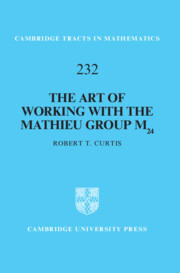Book contents
- Frontmatter
- Dedication
- Contents
- Figures
- Tables
- Preface
- Acknowledgements
- 1 Introduction
- 2 Steiner Systems
- 3 The Miracle Octad Generator
- 4 The Binary Golay Code
- 5 Uniqueness of the Steiner System S(5, 8, 24) and the Group M24
- 6 The Hexacode
- 7 Elements of the Mathieu Group M24
- 8 The Maximal Subgroups of M24
- 9 The Mathieu Group M24
- 10 The Leech Lattice M24
- 11 The Conway Group ·O
- 12 Permutation Actions of M24
- 13 Natural Generators of the Mathieu Groups
- 14 Symmetric Generation Using M24
- 15 The Thompson Chain of Subgroups of Co1
- Appendix MAGMA Code for 7★36 : A9 ↦ Co1
- References
- Index
13 - Natural Generators of the Mathieu Groups
Published online by Cambridge University Press: 31 October 2024
- Frontmatter
- Dedication
- Contents
- Figures
- Tables
- Preface
- Acknowledgements
- 1 Introduction
- 2 Steiner Systems
- 3 The Miracle Octad Generator
- 4 The Binary Golay Code
- 5 Uniqueness of the Steiner System S(5, 8, 24) and the Group M24
- 6 The Hexacode
- 7 Elements of the Mathieu Group M24
- 8 The Maximal Subgroups of M24
- 9 The Mathieu Group M24
- 10 The Leech Lattice M24
- 11 The Conway Group ·O
- 12 Permutation Actions of M24
- 13 Natural Generators of the Mathieu Groups
- 14 Symmetric Generation Using M24
- 15 The Thompson Chain of Subgroups of Co1
- Appendix MAGMA Code for 7★36 : A9 ↦ Co1
- References
- Index
Summary
In this chapter we describe how M24 can be generated by seven involutions that are normalized as a set by a subgroup of M24 isomorphic to the linear group L3(2). These seven elements are described combinatorially as acting on a conjugacy class of 7-cycles in L3(2). They are also described as acting on the 24 heptagonal faces of the Klein map κ, whose 84 edges fall into seven blocks of imprimitivity of size 12 under the action of L3(2); thus there is one permutation for each block. So, remarkably, generators for M24 may be read directly off κ. Analogously we describe how M12 can be generated by five elements of order 3 that are normalized within M12 by a subgroup isomorphic to the alternating group A5. These five elements are described combinatorially as acting on a conjugacy class of 5-cycles in A5. They are also described as acting on the 12 faces of the regular dodecahedron whose 20 vertices fall into five blocks of imprimitivity of size 4 (each of which forms a regular tetrahedron); thus there is one generator for each block. So generators for M12 can be read directly off the faces of the dodecahedron. Galois showed that the only simple groups L2(p) that can act faithfully with degree p are for p = 5, 7 and 11. These constructions for M12 and M24 owe their existence to the cases p = 5 and p = 7.
Information
- Type
- Chapter
- Information
- The Art of Working with the Mathieu Group M24 , pp. 187 - 208Publisher: Cambridge University PressPrint publication year: 2024
